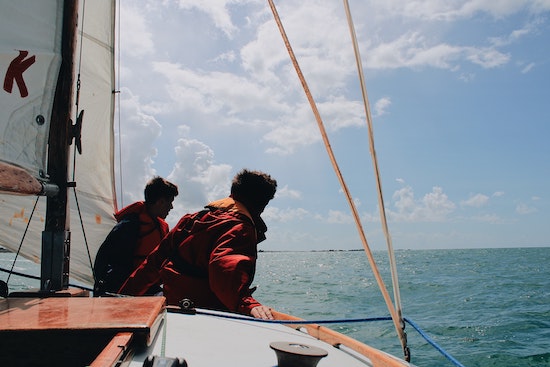Welcome aboard, fellow sailors! Whether you’re a seasoned seafarer or new to the world of sailing, it’s crucial to understand the maneuvers that will power your vessel through the waters. Today, we’ll be diving into the concept of tacking and jibing, two essential techniques that every sailor should master. Tacking and jibing are commonly used to change the direction of a sailing boat, but they differ in execution and purpose. We’ll explore the differences between tacking and jibing, discuss what sailors say during tacking, and delve into the significance of this maneuver. So hoist your sails, tighten your grip on the helm, and get ready to discover the art of tacking!
Introduction
Tacking is a fundamental maneuver in sailing that plays a crucial role in changing a boat’s direction against the wind. It involves turning the boat’s bow through the wind, causing the sails to switch from one side to the other. By performing a tack, sailors can efficiently navigate upwind or against the wind, enabling them to reach their desired destination effectively.
In the process of tacking, the boat’s bow is brought to face directly into the wind, resulting in the sails luffing or fluttering as they lose wind pressure. This momentary pause allows the sails to be trimmed or adjusted to the new tack, preparing them to efficiently catch the wind from the opposite side. Once the sails are properly trimmed, the boat completes the tack by turning the stern through the wind, placing the sails on the opposite side to continue sailing on the new tack.
Tacking is a maneuver that requires coordination and skill from the sailor. It involves a series of precise actions, such as helming the boat into the wind, releasing and controlling the sails, and smoothly transitioning the boat onto the new tack. When executed skillfully, tacking allows sailors to effectively navigate in changing wind conditions and sail efficiently against the wind.
What Is the Difference Between Tacking and Jibing?
The terms “tacking” and “jibing” are commonly used in sailing and are essential maneuvers for changing the direction of a sailboat. Although these terms may seem similar, there is a significant difference between tacking and jibing. Understanding the distinction between these two maneuvers is crucial for sailors to effectively control their boats and navigate through different wind conditions.
Tacking:
- Tacking is a sailing maneuver used to turn the boat’s bow through the wind.
- When tacking, the boat’s bow is pointed into the wind direction, causing the sails to lose power momentarily.
- As the boat passes through the “no-sail zone,” the sails are pushed over to the opposite side to catch the wind from the other side.
- A boat cannot sail directly into the wind due to a lack of lift on the sails. Tacking allows the boat to navigate against the wind by making a series of zigzag movements.
Jibing:
- Jibing, also known as gybing, is a maneuver that involves turning the stern of the boat through the wind.
- In contrast to tacking, jibing is performed when the wind is coming from behind the boat.
- During a jibe, the wind pushes the stern of the boat, causing the sails to swing over to the opposite side.
- Jibing is commonly used when sailing downwind or in a downwind course.
The Difference between Tacking and Jibing:
| Tacking | Jibing |
|---|---|
| Turning the bow through the wind | Turning the stern through the wind |
| Performed when the wind is coming from the front | Performed when the wind is coming from behind |
| Navigates against the wind | Sails downwind |
Both tacking and jibing are essential maneuvers for sailors, allowing them to control their boats effectively and adapt to changing wind conditions. Understanding the difference between these maneuvers is crucial for any sailor looking to navigate through various directions and get the most out of their sailing experience.
What Do Sailors Say When Tacking?
When it comes to sailing, there are certain terms and phrases that are commonly used by sailors. One such phrase is “tacking.” But what do sailors actually say when they are tacking? Before we delve into that, let’s first understand what tacking is. Tacking is a sailing maneuver that involves turning the bow of the boat through the wind, so that the wind changes from one side of the boat to the other. This maneuver allows the boat to change direction and sail against the wind.
When sailors are tacking, there are a few commonly used phrases that you might hear. One of the most common phrases is “ready about” or “ready to tack.” This is a signal to alert the rest of the crew that the boat is about to perform a tack. It prepares everyone on board for the upcoming maneuver. Another phrase you might hear is “helm’s alee.” This is a command given to the helmsman to turn the boat’s helm away from the wind. It instructs the helmsman to start the tacking maneuver by turning the boat in the opposite direction.
As the boat starts to turn, you might hear the crew shout “hard alee.” This is a command to the crew to quickly release any tension on the sheets, which are the ropes used to control the sails. Releasing the sheets allows the sails to freely move with the wind as the boat changes direction. Once the boat has completed the tack and is sailing on the new tack, you might hear the crew say “made it” or “we’re through.” These phrases signal that the tack was successful and the boat is now sailing in the desired direction.
What Does Tacking Do?
In the world of sailing, tacking is a crucial maneuver that allows sailors to change their direction against the wind. When a sailboat is facing directly into the wind, it cannot move forward efficiently. Tacking comes into play in this situation, enabling the boat to maintain progress by using the wind’s power effectively. But what exactly does tacking do and how does it work?
Tacking involves turning the bow of the boat through the wind so that the wind changes from one side of the boat to the other. This maneuver enables the sail to fill with wind from the opposite side, allowing the boat to sail towards the wind at an angle. The concept behind tacking is to navigate a zigzag course known as beating, which helps sailboats reach their desired destination against the wind. By alternating between tacks, sailors can effectively make progress in a direction that would not be possible if they relied solely on the prevailing wind direction.
- Improved Upwind Performance: Tacking plays a vital role in maximizing a sailboat’s performance when sailing upwind. By employing this maneuver, sailors can utilize the full potential of their sails, harnessing the wind’s power even when it’s coming from a direction that would typically hinder progress. This technique allows sailors to sail closer to the wind and reduce the risk of drifting off course due to wind resistance.
- Effective Course Correction: Tacking also serves as an effective means of changing a sailboat’s course. By turning the bow through the wind and adjusting the angle of the sails, sailors can steer the boat in the desired direction. This maneuver is particularly useful when avoiding obstacles or adjusting for changing weather conditions while maintaining forward momentum.
Overall, tacking is a fundamental skill for sailors, enabling them to navigate against the wind, improve upwind performance, and make efficient course corrections. Understanding the purpose and mechanics of tacking is essential for sailors to become proficient in maneuvering their sailboats effectively, whether racing competitively or leisurely cruising. So, the next time you see a sailboat zigzagging across the water, you’ll know that it’s tacking and unlocking the power of the wind to reach its destination.










